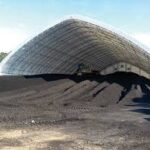In the modern era, environmental sustainability has become a top priority across industries, including dry bulk storage. As businesses seek to reduce their carbon footprint and promote eco-friendly practices, innovative solutions are needed to minimize environmental impact while optimizing storage efficiency. Metalkarma’s spaceframe technologies dry bulk coverage sheds offer a sustainable solution that aligns with these goals. In this blog, we’ll explore strategies for reducing environmental footprint and promoting eco-friendly practices in dry bulk storage using Metalkarma’s innovative technology.
1. Energy-Efficient Design:
Metalkarma’s spaceframe technologies dry bulk coverage sheds are engineered with energy efficiency in mind. These structures feature insulated panels and reflective roofing materials that help regulate internal temperatures, reducing the need for heating or cooling systems. Additionally, natural lighting solutions such as skylights and translucent panels minimize the reliance on artificial lighting, further reducing energy consumption and lowering carbon emissions.
2. Rainwater Harvesting and Recycling:
Water conservation is a critical aspect of environmental sustainability. Metalkarma’s spaceframe technologies dry bulk coverage sheds can be equipped with rainwater harvesting systems that collect and store rainwater for non-potable uses such as irrigation and site maintenance. By recycling rainwater, businesses can reduce their reliance on municipal water sources and minimize water wastage, contributing to overall water conservation efforts.
3. Sustainable Materials and Construction:
Metalkarma’s spaceframe technologies dry bulk coverage sheds are constructed using sustainable materials and construction techniques. The lightweight yet durable spaceframe design minimizes material usage while maximizing structural strength, reducing resource consumption and waste generation. Additionally, the use of recyclable materials ensures that end-of-life sheds can be repurposed or recycled, further minimizing environmental impact.
4. Habitat Preservation and Restoration:
Dry bulk storage facilities often occupy large land areas, potentially impacting local ecosystems and habitats. Metalkarma’s spaceframe technologies dry bulk coverage sheds offer a compact and efficient storage solution that minimizes land disturbance and habitat destruction. By optimizing space utilization and preserving natural landscapes, businesses can contribute to habitat preservation and restoration efforts, promoting biodiversity and ecological sustainability.
5. Carbon Offset and Mitigation:
To mitigate carbon emissions associated with dry bulk storage operations, businesses can invest in carbon offset initiatives such as reforestation projects or renewable energy credits. Metalkarma’s spaceframe technologies dry bulk coverage sheds, with their energy-efficient design and sustainable construction, can help reduce overall carbon footprint, making it easier for businesses to achieve carbon neutrality and promote environmental sustainability.
Conclusion:
Metalkarma’s spaceframe technologies dry bulk coverage sheds offer a sustainable solution for businesses seeking to reduce their environmental footprint and promote eco-friendly practices in dry bulk storage. By incorporating energy-efficient design, rainwater harvesting, sustainable materials, habitat preservation, and carbon offset strategies, businesses can minimize environmental impact while optimizing storage efficiency. With Metalkarma’s innovative technology, the path to environmental sustainability in dry bulk storage is within reach, paving the way for a greener and more sustainable future.






